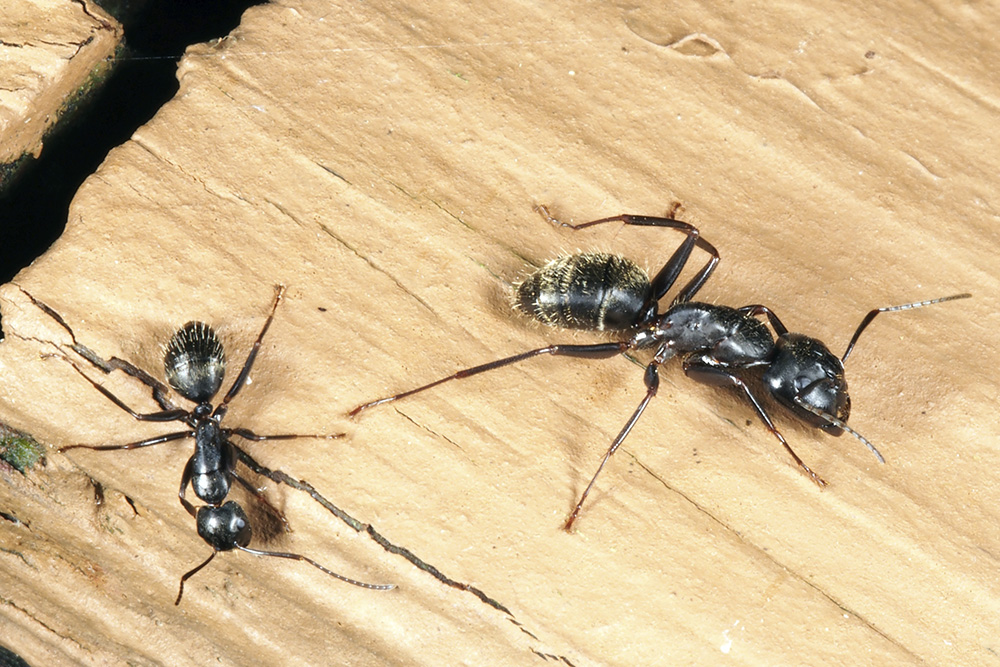
By Jody Green, Extension Educator
Carpenter ants are the most notorious ants for Nebraska homeowners, often called out as the “big black ants.” They are feared because they excavate their nests in wood, which cause damage to building materials of our homes. Carpenter ants, unlike termites, do NOT eat wood. As their name implies, these ants are carpenters. They carve tunnels into wood with chewing mouthparts, creating smooth, sandpapered-like galleries. The wood is kicked out as small piles of sawdust.
SIGNS OF CARPENTER ANTS
• Coarse sawdust with insect parts
• Damaged wood with smooth galleries (no mud or soil)
• Foraging worker(s)
• A large number of winged ants
• Crinkling noises in the walls
IDENTIFICATION
The structure between the thorax and abdomen (called a gaster in ants) is the petiole, and ants are grouped based on whether their petiole has one node or two. Carpenter ants have one node and range in color from black to brown, red and even yellow. The key characteristic of all carpenter ants is the evenly-rounded profile. Workers range from 1/4-inch to 1/2-inch long.
GROWTH OF A COLONY
All ants are social, which means they live in large colonies with overlapping generations, have a distinct division of labor and collectively care for the young. The formation of a colony starts with a single fertilized queen. The queen lays eggs and raises daughter worker ants, which help grow the colony and feed, raise and protect the larvae and pupae.
Carpenter ants are polymorphic, which means they have workers of different sizes, called major and minor workers. Carpenter ant colonies can be a few thousand individuals to 15,000. After several years, the queen produces males and winged reproductives (called alates or swarmers) to disperse in a nuptial flight and start new colonies. This is a seasonal and/or annual event, which are triggered by environmental conditions like temperature and rainfall.
FOOD AND FORAGING
Carpenter ants forage for solid and liquid food, carbohydrates and protein. They feed on a variety of food sources including sugary honeydew secretions produced by plant pests like aphids and mealy bugs, plant exudates and other insects. They also scavenge on carcasses. Workers can only ingest liquid food sources, but larvae can convert solids into liquid food. Foraging ants will feed the immobile, legless larvae solids and the larvae will regurgitate it back to the workers and allow it to be fed to the queen.
Carpenter ants are nocturnal insects and can be found foraging at night between the hours of 10 p.m. and 2 a.m. They follow structural and physical guidelines such as tree branches, electrical wires, clothes lines and edges of items. They lay down trail pheromone by dragging their gaster along the substrate, to communicate to nestmates the location of food. They can forage long distances, up to 100 yards (300 feet) from the nest.
INSPECTION FOR NESTS
Carpenter ants are known for having large, decentralized colonies called satellite colonies. Often the main or parent colony is located outdoors in moist, rotten or decayed wood, and the satellite colonies can be found in higher, drier areas inside or outdoors. Nests can be found in the following locations: Tree limbs, tree holes, stumps, firewood, logs, landscape timbers, living trees, dead trees, deck posts, porches, fence posts, structural members, foam insulation, hot tubs, crawlspaces, attic, roof overhangs, hollow doors, bay windows, bath traps and chimneys.
Carpenter ants do not kill live trees. Older trees may have a significant amount of decay due to excessive moisture, which ants take advantage of to easily excavate galleries. Ants are a sign of dead wood, not the cause of tree death. Carpenter ant nests may extend into sound wood over time. Cutting down trees or filling cavities is not advised, although some arborists may choose to treat the trunk.
CONTROL METHODS FOR HOMEOWNERS
• Remove food sources (this may mean reducing sap-feeding insects that produce honey dew).
• Reduce sources of moisture (roofs, leaky windows or skylights, poor grading, full or faulty gutters and downspouts, condensation, malfunctioning appliances).
• Eliminate wood to soil contact.
• Remove vegetative cover from foundation.
• Prune trees and shrubs so there is no contact with the structure.
• Seal cracks and holes like utility entrances and wires.
• Provide adequate ventilation in crawlspaces, basements and attics.
• Locate the nest and treat with labeled insecticide.
• Only use bait labeled for carpenter ants. This can be liquid, gel or solid granular, but must be attractive, palatable and slow-acting. Sugar-bait alone will not eliminate the colony due to the wide range of nutritional requirements.
• Consider contacting a professional pest management company.